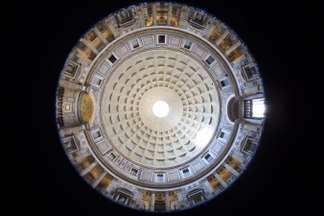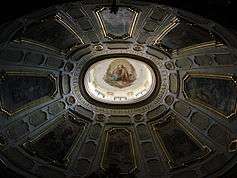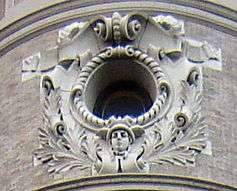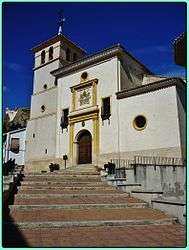Oculus
An oculus (plural oculi, from Latin oculus, 'eye') is a circular opening in the center of a dome or in a wall. Originating in antiquity, it is a feature of Byzantine and Neoclassical architecture. It is also known as an œil-de-boeuf from the French, or simply a "bull's-eye".[1]

Classical example
The oculus was used by the Ancient Romans, one of the finest examples being that in the dome of the Pantheon. Open to the weather, it allows rain to enter and fall to the floor, where it is carried away through drains. Though the opening looks small, it actually has a diameter of 27 ft (8.2 m), allowing it to light the building.
Byzantine architecture
The oculus was widely used in the architecture of the Byzantine Empire. It was applied to buildings in Syria in the 5th and 6th centuries and again in the 10th century. In Constantinople's Myrelaion Church (c. 920), there are two oculi above the stringcourse on both lateral facades.[2]
Neoclassical revival
Early examples of the oculus in Renaissance architecture can be seen in Florence Cathedral, in the nave clerestory and topping the crowns of the arcade arches.[3]
Since the revival of dome construction beginning in the Italian Renaissance, open oculi have been replaced by light-transmitting cupolas and other round windows, openings, and skylights. They can be seen in the pediments of Palladio's Villa Rotonda, though not in the dome. Use of oculus windows became more popular in Baroque architecture. Widely used by Neo-Palladian architects including Colen Campbell, one can be seen in the dome of Thomas Jefferson's Rotunda at the University of Virginia.[1][4]
 Effect of the view into a cupola through an oculus under natural light (Wambierzyce, Poland)
Effect of the view into a cupola through an oculus under natural light (Wambierzyce, Poland) Detail of oculus set in a cartouche with the head of Mercury (Beaux-Arts New York and New Jersey Telephone Company Building, Brooklyn)
Detail of oculus set in a cartouche with the head of Mercury (Beaux-Arts New York and New Jersey Telephone Company Building, Brooklyn)
 Oculi in San Pedro, Calasparra, Spain
Oculi in San Pedro, Calasparra, Spain Facade of the Colegio Grande, completed in 1749,[5][6] of the San Ildefonso College, in Mexico City, Mexico
Facade of the Colegio Grande, completed in 1749,[5][6] of the San Ildefonso College, in Mexico City, Mexico
References
- "Oculus window". Royal Institute of British Architects. March 27, 2014. Archived from the original on March 27, 2014. Retrieved 24 January 2014.
- Ćurčić, Slobodan; Johnson, Mark Joseph; Ousterhout, Robert G.; Papalexandrou, Amy (1 January 2012). Approaches to Byzantine Architecture and Its Decoration: Studies in Honor of Slobodan Ćurčić. Ashgate Publishing, Ltd. pp. 148–. ISBN 978-1-4094-2740-7. Retrieved 24 January 2013.
- "The Cathedral of Santa Maria del Fiore, Florence". muohio.edu. March 27, 2014. Archived from the original on March 27, 2014. Retrieved 24 January 2013.
- "Daylighting in two centroidal spaces at the University of Virginia: Case Study, The Rotunda and Caplin Pavilion". The University of Virginia. Retrieved 24 January 2013.
- "Acerca del museo". Colegio de San Idelfonso Official website.
- Galindo, Carmen; Magdelena Galindo (2002). Mexico City Historic Center. Mexico City: Ediciones Nueva Guia. pp. 86–91. ISBN 968-5437-29-7.
External links
![]()